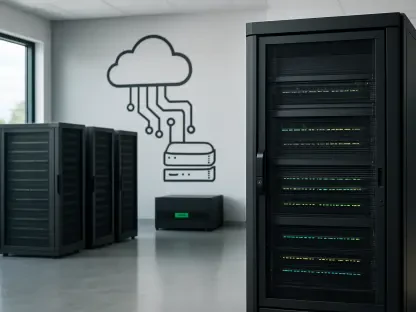In the ever-evolving landscape of material production, a seismic shift is underway as industry leaders grapple with the limitations of outdated technology while embracing the transformative power of modern tools. Across multi-site operations, producers are finding that clinging to legacy systems—once reliable for basic tasks—now poses significant barriers to growth, efficiency, and competitiveness. The urgency to modernize has never been clearer, with cloud-based solutions emerging as the go-to strategy for overcoming operational silos and unlocking real-time insights. This transition isn’t merely a trend but a strategic necessity, driven by the need to streamline processes, enhance visibility, and adapt to tightening margins. As the industry faces increasing complexity, the move to cloud technology represents a pivotal moment for producers aiming to stay ahead of the curve and redefine their approach to scalability and customer responsiveness.
Challenges of Legacy Systems in Modern Operations
Fragmented Systems Stifle Growth
Legacy systems, once the backbone of material production operations, are increasingly proving to be a liability in today’s fast-paced, multi-site environments. Designed for simpler tasks like printing tickets and recording loads, these outdated platforms struggle to meet the demands of complex, interconnected businesses. The result is often a fragmented setup where data remains siloed across locations, cost centers, and ERP entities. This disconnection leads to sluggish reporting and a lack of real-time visibility into critical metrics, making it difficult for producers to make informed decisions swiftly. Moreover, the inability to scale or customize these systems without significant effort compounds the problem, leaving companies stuck in inefficiencies. As operations expand, the cracks in legacy infrastructure become glaring, with untapped profit potential and operational bottlenecks emerging as persistent challenges that hinder long-term growth.
High Costs of Inertia and Resistance to Change
Beyond operational fragmentation, the reluctance to abandon familiar systems imposes a steep cost on producers who prioritize short-term comfort over long-term gains. Many companies hesitate to move away from legacy setups due to the perceived risks of disruption or the upfront investment required for modernization. However, this inertia often results in missed opportunities to optimize workflows and improve customer experiences. The lack of seamless integrations with modern tools further exacerbates inefficiencies, forcing teams to rely on manual processes or cumbersome workarounds. Additionally, limited IT support for outdated systems means that maintenance becomes increasingly expensive and time-consuming. As competitors adopt more agile solutions, those stuck with legacy technology risk falling behind, unable to respond to market shifts or capitalize on emerging trends. The hidden price of sticking with “good enough” is a diminished ability to adapt, ultimately threatening market position and profitability.
Benefits and Trends Driving Cloud Adoption
Unifying Operations with Real-Time Insights
A growing number of producers are turning to cloud-based solutions to address the shortcomings of legacy systems, and the advantages are proving transformative. Unlike traditional setups, cloud platforms are built to unify operations across multiple sites, providing a centralized hub for production, sales, and financial data. This real-time visibility empowers decision-makers to track performance metrics instantly, enabling quicker responses to operational challenges. Custom workflows tailored to specific needs further enhance efficiency, while seamless integrations with both modern and older tools reduce the friction of adopting new technology. The minimal IT demands of cloud systems also mean faster onboarding, allowing companies to focus on core business activities rather than technical hurdles. This shift toward unified, accessible data is redefining how producers manage complexity, positioning them to scale with confidence and agility.
Success Stories Highlight Measurable Impact
Concrete examples of cloud adoption underscore its potential to revolutionize material production operations. Consider a vertically integrated producer in the Mid-Atlantic region that recently made the switch to a cloud solution. The results were immediate and striking: a modernized sales process with real-time data access improved customer interactions, while digital ticketing streamlined compliance with Department of Transportation regulations. Back-office functions also saw significant gains, with automated reconciliation and centralized invoicing reducing administrative burdens. These improvements reflect a broader industry trend where cloud technology not only addresses inefficiencies but also enhances responsiveness to client needs. Such success stories demonstrate that the benefits of modernization extend beyond operational metrics, fostering stronger relationships with stakeholders and paving the way for sustained growth. As more producers witness these tangible outcomes, the momentum for cloud adoption continues to build.
Strategic Path Forward for Industry Leaders
Overcoming Barriers to Modernization
Reflecting on the transition from legacy systems, it’s evident that many producers hesitated due to concerns over cost, disruption, or unfamiliarity with new technology. Yet, those who took the leap found that cloud solutions offered scalable frameworks that minimized these risks. Comprehensive training and phased implementations often eased the shift, while vendors provided robust support to ensure smooth integration. The focus back then was on addressing immediate pain points like siloed data and slow reporting, and the results showed that modernization was less daunting than anticipated. By prioritizing strategic planning and stakeholder buy-in, companies overcame initial barriers, setting a precedent for others to follow. This historical perspective highlights that the path to cloud adoption, though challenging at times, was navigated successfully through deliberate and informed approaches.
Building Resilience for Future Challenges
Looking ahead, producers who embraced cloud technology in the past positioned themselves to tackle evolving industry demands with greater resilience. The next steps involve leveraging these platforms to drive innovation, such as integrating advanced analytics for predictive insights or adopting automation for even leaner operations. Exploring partnerships with technology providers can further enhance capabilities, ensuring systems remain adaptable to future needs. Additionally, fostering a culture of continuous improvement will be key to maximizing the value of cloud investments. As margins tighten and complexity grows, staying proactive in refining digital strategies will distinguish industry leaders from laggards. The journey of modernization, as seen in earlier transitions, offers a blueprint for building adaptable, forward-thinking operations ready to seize emerging opportunities and navigate uncertainties with confidence.









